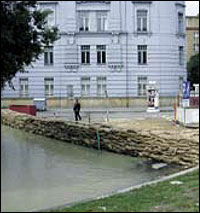|
|
The
future of sustainable flood protection
ICPDR
releases the Flood Action Programme to help Danube Basin communities reduce
the risk of flood damages.
|
|
|
|
Bratislava declares a state of emergency as
flood-waters submerge the city in 2002. Catastrophic floods force residents
to evacuate across the basin. |
Rising dangers.
The Communication on Flood Risk Management issued recently by the European
Commission indicated that between 1998 and 2002, Europe suffered over 100
damaging floods, including the catastrophic floods along the Danube and Elbe
rivers in 2002. Since 1998, floods have caused 700 fatalities, the displacement
of about half a million people, and at least 25 billion Euros in insured
economic losses. More-over, floods also cause severe environmental impacts by
inundation of areas containing toxic or hazardous substances.
As a response to these dangers, the ICPDR established the Flood Protection Expert
Group in 2002 to prepare the Action Programme on Sustainable Flood Protection
in the Danube River Basin.
Targeting the
high-water mark.
The overall goal of the action programme is to achieve a long-term and
sustainable approach to managingthe risk of floods, while encouraging
conservation and improvement of water-related ecosystems. It describes the
principles, targets and measures concerning flood protection on a basin-wide
level and guides the preparation of action plans for flood protection on a sub-basin
level. Considering the damage floods cause, a formal agreement on a joint
programme is of supreme importance.
“The Action Programme sets very important targets and specifies measures to
manage the growing flood risks on local, regional, sub-basin and basin-wide
level,” says Sandor Toth, chairman of ICPDR’s Flood Prevention Expert Group.
The programme covers the improvement of early flood warning and forecast, as
well as the assessment of flood-prone areas and evaluation of flood risks.
A swell of success.
The key to success in preventing flood damage will be to link national and
regional systems, and the programme calls for the development of a basin-wide
Blöchearly warning system by the end of 2006 and sub-basin action plans by
2009. “Since successful and effective flood risk management is the prerequisite
of sustainable regional development, I am convinced that by the implementation
of this Action Programme the whole Danube River Basin will benefit”, says Toth.
For more
information: www.europa.eu.int/comm/environment/water/index.html
PREVENTION
AND PROTECTION - THE EUROPEAN DIMENSION
After
the disasters of the 2002 floods, all of Europe is taking action against floods
·
In 2003,
the EU created a comprehensive EU document on best practices in flood
prevention and protection.
·
In July
2004, the European Commission presented its Communication ‘Flood Risk
Management’, analysing causes and impacts and proposing concerted European
action. Such action should build on experience and ongoing activities such as
the Flood Action Plans for the Danube, Rhine, Elbe and Oder basins.
·
In
October 2004, the EU Environment Ministers unanimously supported the analysis
of the Flood Risk Communication and called for the European Commission to draft
a legislative proposal.
The
shape of future EU flood actions
·
A
proposed EU Floods Directive will provide for mandatory cooperation within
river basins and across borders, for risk zone mapping and for flood action
plans as the operative instrument for flood prevention and flood protection,
using information from citizens, stakeholders and NGOs. The legislative
proposal is expected in autumn 2005, and implementation will be guided,
together with that of the Water Framework Directive, by EU Water Directors.
·
EU
funding instruments such as Structural and Cohesion Funds, LIFE, but also the
revised EU Agricultural Policy will provide financial support, from training
and information to operational measures for prevention and protection.
Helmut
Blöch
